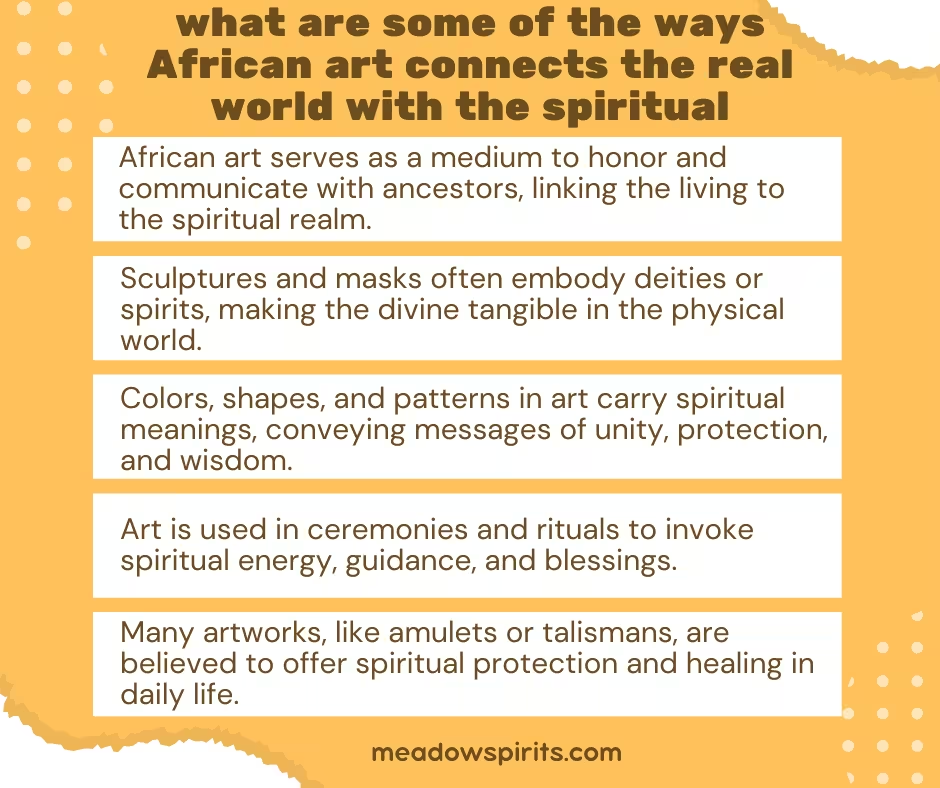
African art has been amazing people for hundreds of years. It’s not just pretty to look at. It also connects the real world with the spiritual one.
In Africa, masks and statues are very important. They carry deep spiritual meanings. They show the beliefs and traditions of the people.
African art is a way to see into the spiritual life of the people. It honors ancestors and shows sacred rituals. These artworks link the real world with the spiritual one.
By looking at African art, we learn about the culture and beliefs of the people. It helps us understand the spiritual traditions of Africa.
Symbolism in African Art: Bridging the Physical and Spiritual Realms
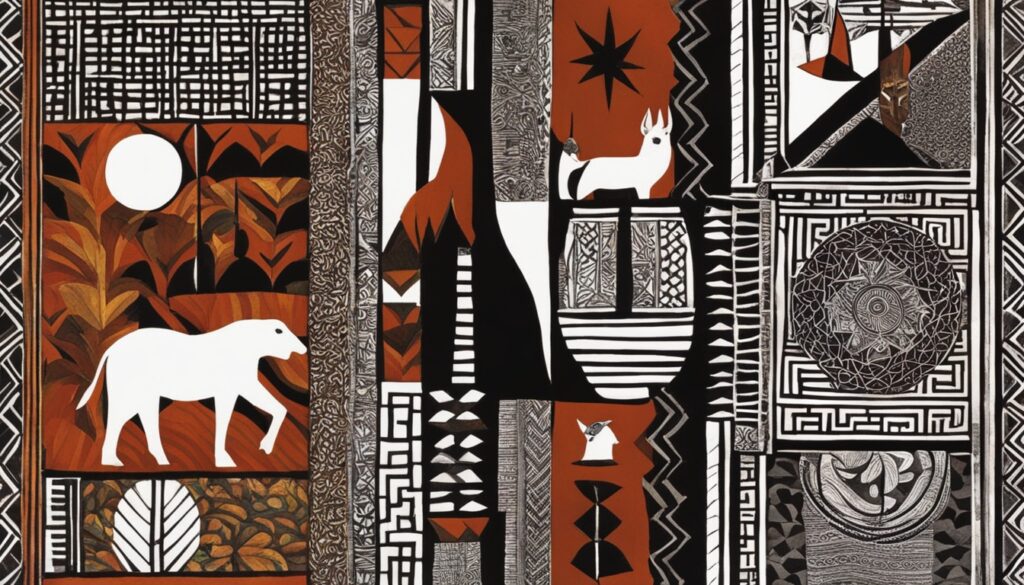
Symbolism is key in African art. It shows spiritual beliefs and cultural identity. Art in Africa links the physical and spiritual worlds closely.
Masks in Africa mean a lot spiritually. They are used in events to show respect and wonder. They are more than art; they are important symbols.
Statues like the Hogon equestrian show power and wisdom. They connect to fertility gods. This links the real and spiritual worlds together.
African beliefs mix spiritual and secular life. Everything is seen as connected to the invisible world.
African beliefs can be seen as a triangle. The top is the Supreme Being, and the base has lower forces. Religion and culture are closely linked in African life.
African art shows the continent’s creativity and spiritual beliefs. It gives us a peek into African culture and its art traditions.
Representation of Ancestors and Ancestral Veneration
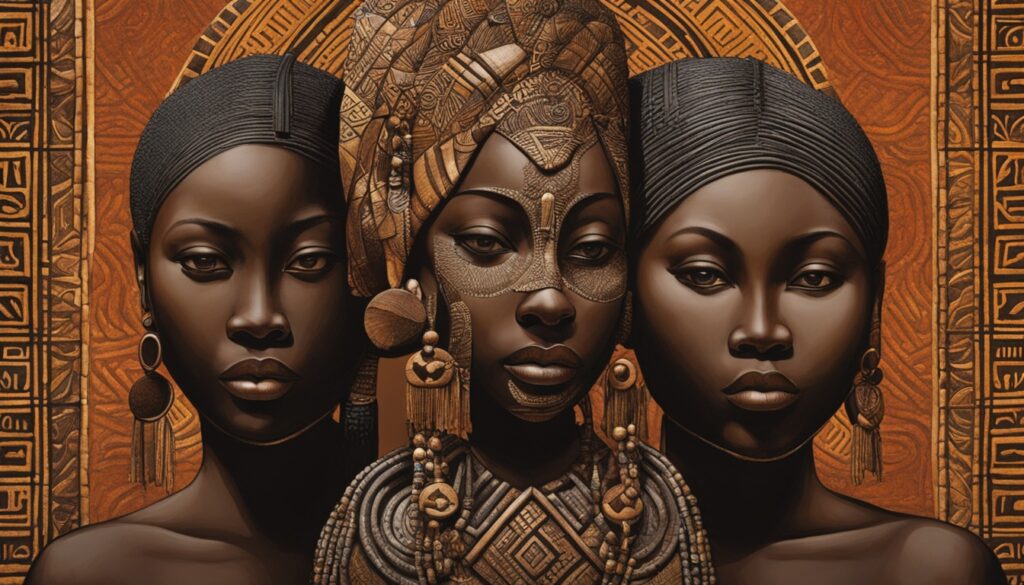
In African art, ancestors are very important. They show respect and keep ancestors kind to us. These artworks are key in sacred places. They keep the impact of ancestors alive with spiritual symbols and remembering our culture.
Shrine sculptures show the big role of influential Africans. They keep a deep link with powerful ancestors.
Ancestors and honoring them are big parts of African spirituality. Funerals in Africa are long, lasting weeks, months, or even years. This shows how important they are, unlike in the U.S.
Funerals are big events that show the spiritual world’s impact on African life. People believe the dead stay close to the living.
African Traditional Religion (ATR) focuses on honoring the dead. It doesn’t have written texts because it’s an oral culture. Initiates don’t easily share deep ATR knowledge with outsiders. This shows how much they respect their ancestors and spiritual symbols.
The Egungun costumes are made with a secret and expensive process. They act as a shrine for the Egungun spirit. This shows the deep link between the physical and spiritual worlds.
African people honor and remember their dead as a religious act. They do this alongside Christianity and Islam in Africa. This practice seeks the help of ancestors and keeps a strong link with the spiritual world.
The art of Africa shows the bridge between the physical and spiritual worlds. It keeps the legacy and influence of ancestors alive.
Functional Purposes: Fertility, Protection, and Ceremonies
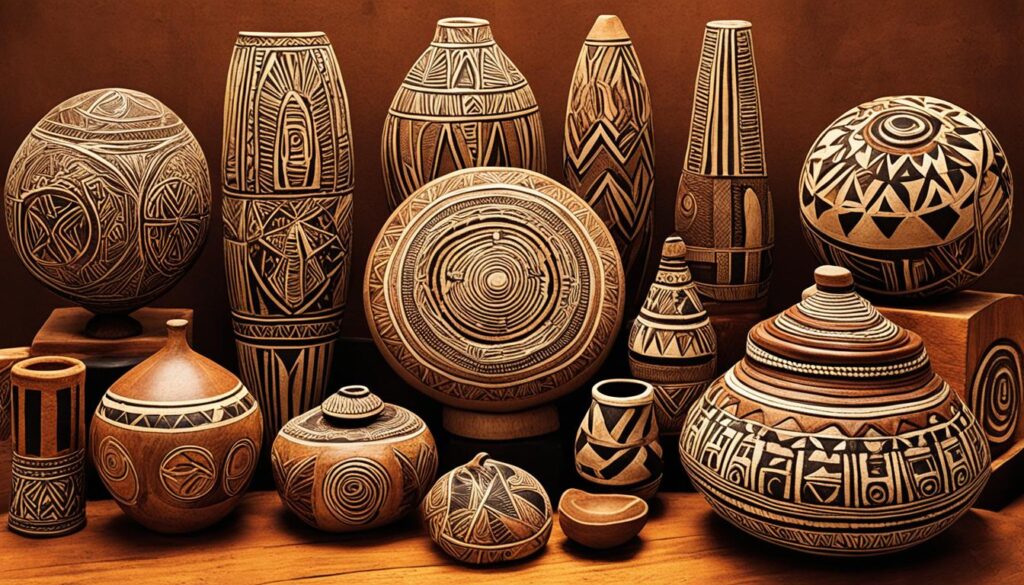
African ritual art is a big part of many communities’ spiritual lives. Masks, statues, and sculptures connect the physical and spiritual worlds. They are used in important events to call upon gods and remember ancestors.
These art pieces celebrate life’s big and small moments. Each one tells a story and has deep cultural meaning.
In African societies, having children is very important. It keeps life going and ensures the family’s future. Being childless is seen as a curse because it stops the cycle of life.
Art of Mother and Child figures helps with pregnancy and birth. They show how important having children is in these cultures.
African ritual art also protects people from evil spirits and brings luck. New babies are seen as the return of ancestors’ protective spirits. This idea of reincarnation links the past, present, and future together.
Children are thought to carry the spirits of their ancestors. This belief connects the past and future through the birth of new life.
African art’s main uses are for fertility, protection, and ceremonies. These art pieces link the physical and spiritual worlds. They help keep life going and honor ancestors’ traditions.
what are some of the ways African art connects the real world with the spiritual
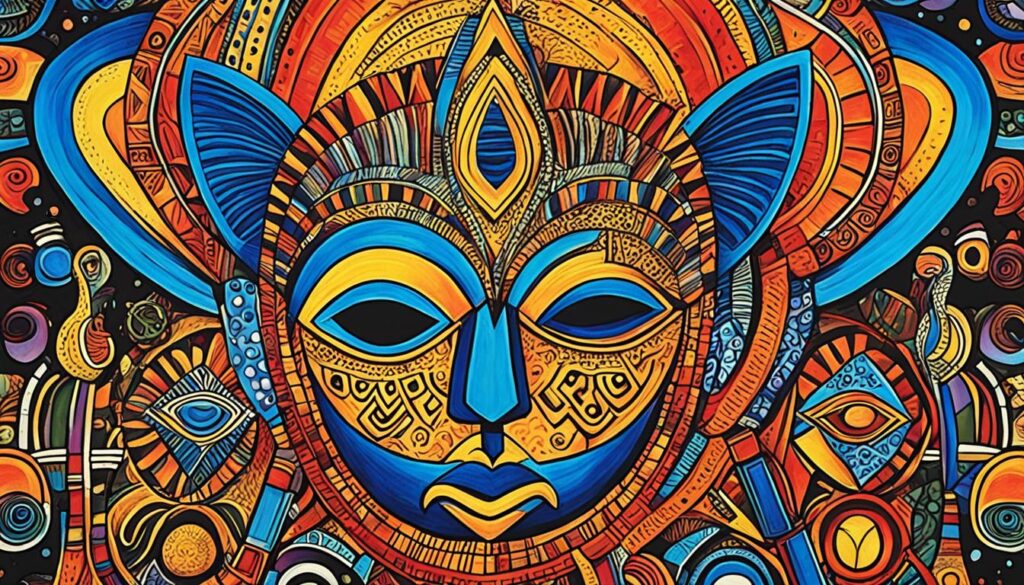
African art links the real world with the spiritual. It’s a key way to share stories and honor leaders. It also shows the rich beliefs of Africa’s people.
Each piece of art tells a deep story. It uses special styles and symbols. These symbols help talk to ancestors and gods.
African art is more than just pretty things. It’s a way to show personal and cultural feelings. It shows how the spiritual world touches our daily lives.
Traditional African items were made for more than just looking good. They were made to do special things. Things like masks and statues could connect us to spiritual powers.
By making and using these items, African people kept close to their spiritual beliefs. They honored their ancestors and called on their gods for protection. This mix of the real and spiritual is what makes African art so special.
Masks and Statues: Spiritual Meanings and Ritualistic Use
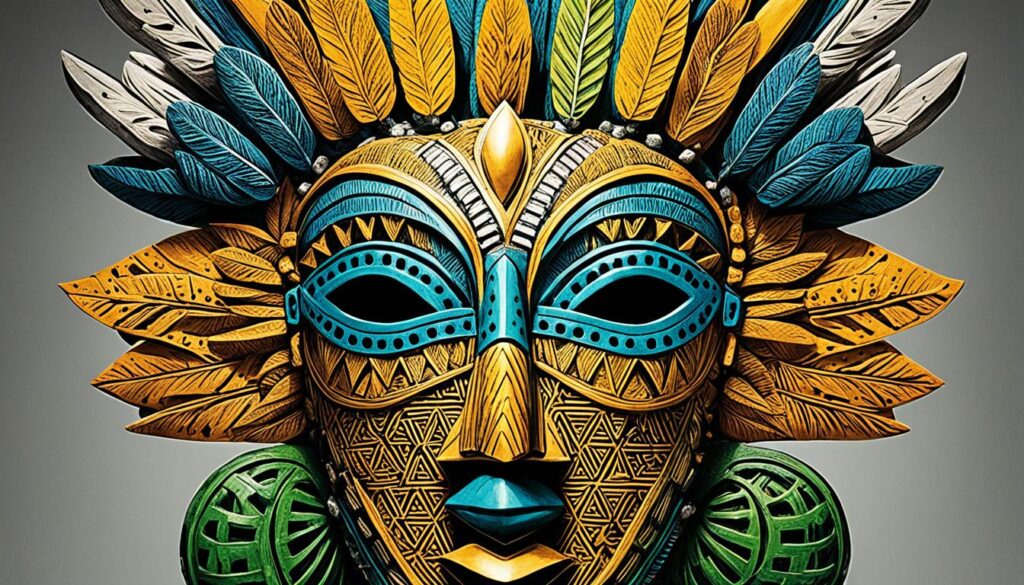
African art is deeply spiritual. It shows in the masks and statues that are symbols of the continent’s culture. These pieces have deep spiritual meanings. They are key in rituals and ceremonies of African communities.
Masks are very important for their deep symbols. They are not just for show. They are key in spiritual beliefs. At secret meetings and big events, masks connect the real world with the spiritual one.
The Dogon people of Mali make sculptures for personal or community worship. Horses in their art mean power and wealth.
Statues have spiritual and practical roles in African life. The Hogon equestrian figure shows power and links to gods. It connects the living with the divine.
Female statues with big breasts and navels carry objects like calabashes. They are seen as “power objects” for talking to the spirit world.
African masks and statues are more than just art. They are key parts of the continent’s spiritual heritage. From making them to using them in ceremonies, they link the real and spiritual worlds.
Art as a Bridge Between the Living and the Spiritual World
African art connects the world of the living with the spiritual. It tells stories and honors important people. This art keeps a strong spiritual link, using symbols to connect us to the sacred.
For over a hundred years, African art has amazed people all over the world. Thousands of sculptures came to Europe in the 1870s because of colonialism and explorers. European collectors saw the beauty in these pieces, making them popular.
This interest helped artists like Picasso and Matisse add African styles to their work in the 1900s.
African art is complex and hard to put into one group. It has been traded, copied, and artists have moved around. This has made African art diverse and rich.
It stands out with its new forms, abstract looks, balanced yet not perfect shapes, and deep meanings. These things make African art a bridge between our world and the spiritual one.
Materials and Mediums: Expressing Cultural Identity
African art is full of rich traditions. Artists use different materials to show who they are. They use shiny metals, clay, and wood. Each piece has deep meaning, showing the beliefs of the people who made it.
The Kente cloth from Ghana is a great example. It’s a colorful fabric that tells stories. The patterns and colors show the history and culture of the Akan people. Wood carvings, clay pots, and beaded textiles also tell stories of their cultures.
These materials help keep African heritage alive. Every piece of art tells a story. It invites us to learn about the culture of Africa. Artists use their skills to share their culture with the world.
African art shows the beauty of its cultures. These materials help us see the traditions of Africa. They remind us of the rich culture behind African art.
The Human Figure: Embodying Spiritual and Cultural Beliefs
In African art, the human figure is very important. It often shows people like chiefs, dancers, or hunters. Some art also shows gods or spiritual helpers.
The Dogon people of Mali make sculptures with arms up. These show their deep religious and cultural beliefs.
African art connects art with spiritual and cultural beliefs. It’s not just for looks. It tells about the values, beliefs, and ways of life of the people. The human figure links the real world with the spiritual one.
Traditional African art shows the human figure in many ways. From masks to statues, these pieces are more than pretty. They carry spiritual beliefs and help show who people are.
The materials used, like wood or stone, add meaning. They connect the real and spiritual worlds.
The human figure in African art shows how important each person is in their community. It also shows the close link between the body and spirit. African art keeps culture alive and helps us understand its deep traditions.
Color Symbolism: Conveying Emotions and Spiritual Meanings
In African art, color is very important. It tells us about feelings and spiritual things. Unlike Western art, African art uses color to share deep meanings.
Colors in African art talk to our souls. For example, red might mean danger or energy. Other colors have special meanings in their culture. This way, African artists make art that touches us deeply.
African art shows the spiritual life of the continent. It connects us to nature and the spirit world. Colors have special meanings, coming from nature, culture, or the spirit world. This shows how African art links the physical and spiritual worlds.
African artists use color to make us feel many things. Their art goes beyond just looking good. It invites us to see into the culture and beliefs of Africa.
The Role of African Art in Rituals and Ceremonies
African art is a key part of many spiritual and religious traditions. It connects the physical and sacred worlds. Masks and sculptures are used in rituals and ceremonies.
They help call upon deities, honor ancestors, and celebrate important life events. These art pieces combine music, dance, and community. They show how art, culture, and the spiritual world are linked in African societies.
The Queen Mother Pendant Mask from the 16th century was made by the Edo people of Benin. It symbolizes the legacy of a royal dynasty. It honors the king’s mother Idia during special ceremonies.
The Benin Bronzes, like the Military Leader relief plaque, show the strength and power of the Benin Kingdom. Artists carved them to highlight the kingdom’s military might. This art helped show the king’s power.
African indigenous practices are still important, even as Christianity and Islam grow. The African diaspora has spread these practices. This includes Cuban Regla de Ocha, Haitian Vodou, and Brazilian Candomblé.
This shows how important African art is in rituals and ceremonies worldwide.
